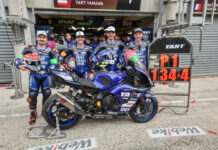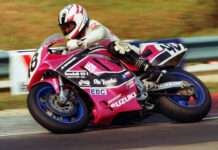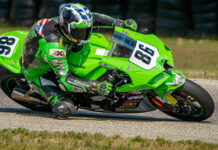The Grand Prix Commission, composed of Mr Carmelo Ezpeleta (Dorna, Chairman), Claude Danis (FIM), Hervé Poncharal (IRTA) and Takanao Tsubouchi (MSMA), in the presence of Mr Alonso (Dorna) and Mr Paul Butler (Secretary of the meeting), in a meeting held on July 25 in Donington (Great-Britain), decided unanimously to introduce the following amendments to the Road Racing World Championship Grand Prix Regulations. (Changes to the Press Release of 08 April in bold). For immediate application: – Sporting Regulations – Practice Restrictions For the purpose of practice restrictions the year is divided into 2 parts. The Season is defined as the period starting 14 days before the first race of the year and ending 2 days after the last race of the year, both dates being inclusive. The season does not include “Breaks”. A Break is defined as two consecutive week-ends where events are not scheduled. The period of the Break extends from 09h00 on the second day after the Grand Prix until the following Grand Prix. The Winter is defined as the rest of the year i.e. starting 4 days after the last race of the season and ending 15 days before the first race of the subsequent season both dates being inclusive. MotoGP Class Practice by contracted riders with machines eligible for the MotoGP class is forbidden: i) During the Season and the breaks at any circuit included in the Grand prix calendar of the current year with the following exceptions: a) Practice included in the schedule of the events. b) Practice during the day(s) immediately following the event at 3 circuits at which the event has taken place. (The final race of the Season will always be at one of the 3 circuits, and it will be the only 2-day test, the others will be 1-day only. The other 2 circuits must be nominated by the Grand Prix Commission by January 31st of that year.) c) Any activity authorised by the Race Direction. ii) During the Winter at any circuit with the following exceptions: a) At a maximum of 6 days of official tests organised by Dorna/IRTA at Grand Prix circuits included in the calendars of the preceding or following year. No testing is permitted during the period starting on the 1st December of one year and finishing on 31st January of the following year, both dates being inclusive. The Winter test schedule must be approved by the Grand Prix Commission. b) Any activity authorised by the Race Direction. Practice by non-contracted riders: Practice by non-contracted riders (test riders) is allowed at any circuit at any time, but limited by the use of a total of 240 tyres per manufacturer, per calendar year, supplied exclusively by the MotoGP tyre supplier. However, it is forbidden to test: During the Season and the Breaks at a Grand Prix circuit included in the calendar before the race has taken place. However manufacturers may, before 31st January of each year, designate and inform the Race Direction of their 2 testing circuits at which they may test but not as from 14 days of the event scheduled at the circuits. The schedule of such tests and any subsequent amendments must be notified to the Race Direction at least 7 days in advance. Definition of a “contracted rider” and a “Rookie” rider A contracted rider is a rider who has participated in nine or more events during one season. A “Rookie” is a rider nominated by a participating team for participation in the entire season, who has not been a contracted rider as defined above in the same class in any previous season. For the purpose of this clause, the 500cc class and the MotoGP class are considered to be the same, as are the 250cc class and the Moto2 class. – Technical regulations – 2.3.6 Engine Durability. 1.) In the MotoGP class the number of engines available for use by each rider is limited. For the 2009 season a maximum of 5 engines may be used by each rider for the final 7 scheduled races of the season, that is from and including the Czech Grand Prix until the end of the season. Should a rider be replaced for any reason, the replacement rider will be deemed to be the original rider for purposes of engine allocation. 2.) The engines available for the exclusive use of each rider must be marked and sealed by the Technical Director prior to first use. It is the Team’s obligation to register any new engine with the Technical Director prior to use. Once registered and used for the first time, engines may not be swapped between riders, even within the same team. A new engine is deemed to be used when the motorcycle with that engine crosses the transponder timing point at the pitlane exit. 3.) The engines will be sealed by means of wiring and identification tabs, so that: a. the timing system is not accessible (e.g. the head cover must be wired to the cylinder head) b. the timing driving system is not accessible (e.g. the geartrain/chain cover is wired so that it cannot be removed), c. the cylinder head and the cylinders block (if any) cannot be removed from the engine (e.g. the cylinder head is wired to the cylinders block and the cylinders block is wired to the engine crankcase), d. the crankcase cannot be opened (e.g. the crankcase halves are wired together). All the parts that are accessible without removing the sealing wiring can be replaced. Breaking or removing the sealing wiring without supervision by the Technical Director will be deemed to be “engine rebuilding” and engines with broken or missing security seals will be treated as a new engine in the allocation. 4.) Should a competitor, for any reason (e.g. mechanical failure, crash, major damage, etc.) require the use of another engine above their allocation, the Technical Director must be informed before the new engine is used, and Race Direction will apply the appropriate penalty. The damaged engine will be removed from the allocation and if it is used again, it will be treated as a new engine with the appropriate penalty. 5.) There is no limit to the number of times a sealed, allocated engine can be fitted to and used in a motorcycle, provided the security seal is not broken or removed. Replacing an engine with another sealed engine (new or used) from the rider’s allocation is allowed with no penalty. 6.) To prevent the running of a used, allocated engine outside of MotoGP events, all allocated engines will have security seals placed over either exhaust or inlet ports (on at least one cylinder bank, in the case of V-type engines) before leaving the circuit. Teams wishing to re-use such an allocated and sealed engine must request the Technical Director to remove the security seals. If the Technical Director or his staff find that the security seals are not intact, the engine will be deemed to be a new engine in the allocation, with the appropriate penalty. 2.3.7 Exhaust Gas Recirculation (EGR) systems are not permitted. 2.3.8 Control Systems 2.3.8.1 The use of hydraulic and/or pneumatic pressurized powered systems is not allowed, with the exception of cylinder inlet/exhaust valve springs. All hydraulic systems on the motorcycle must be powered only by the rider’s manual inputs. Normal hydraulic hand/foot controls such as master/slave cylinders for brakes/clutch are allowed. Pneumatic engine valve actuating systems are allowed. Oil/water pumps for engine lubricating/cooling are allowed. The use of engine lubricating oil for any purpose other than lubrication and cooling (such as powered hydraulic systems) is not allowed. 2.7.3 Brakes 2.7.3.1 Motorcycles must have a minimum of one brake on each wheel that is independently operated. 2.7.3.2 In the 125cc and 250cc classes, only brake discs of ferrous materials are allowed. 2.7.3.3 In all classes, ceramic composite materials are not permitted for brake discs or brake pads. Ceramic materials are defined as inorganic, non metallic solids (e.g. Al2O3, SiC, B4C, Ti5Si3, SiO2, Si3N4). 2.7.12 Suspension and Dampers 2.7.12.1 Electric/electronic controlled suspension and steering damper systems are not allowed. Adjustments to the suspension and steering damper systems may only be made by manual human inputs and mechanical/hydraulic adjusters. 2.10 Numbers and Backgrounds 2.10.1 Racing numbers must be affixed to the front and the two sides of the motorcycle. For the MotoGP class, only the front number is compulsory. 2.10.2 Numbers should be a minimum height of 140 mm. 2.10.3 Numbers must be easily legible and contrast strongly with the background colour. 2.10.4 Backgrounds must be of one single colour over an area large enough to provide a minimum clear area of 25mm around the numbers. 2.10.5 In case of a dispute concerning the legibility of numbers, the decision of the Technical Director will be final.
FIM Grand Prix Commission Introduces New MotoGP Rule Amendments
FIM Grand Prix Commission Introduces New MotoGP Rule Amendments
© 2009, Roadracing World Publishing, Inc.






